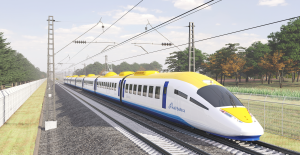- Rail Baltica has evolved significantly since its 2017 cost-benefit analysis, influenced by inflation, scope expansion, and more accurate data;
- Rail Baltica’s economic benefits, both direct and induced, are expected to surpass costs and amount in total to 48 billion EUR for the Baltic states;
- The project actively seeks diverse financial resources, including private investment and loans, contingent upon the next EU budget;
- Phased project implementation aims to complete the necessary scope for operations by 2030, with the remaining scope implemented after 2030;
- Risk and change management are an integral part of Rail Baltica’ project management; further development of unified change and risk management for the global project is of the highest importance;
- Operational readiness by 2030 is the project’s focus, encompassing rolling stock availability and service providers.
RB Rail AS, the central global project coordinator, and the Rail Baltica implementing organizations in Estonia, Latvia and Lithuania, have closely cooperated with national State Audit Office institutions, following and implementing their recommendations. In the past six months, as part of the analysis conducted by the Supreme Audit Institutions (SAIs) of Estonia, Latvia, and Lithuania, management teams and experts from Rail Baltica delivery organizations have supported the process by providing necessary inputs and actively engaging in the work.
In the previous years, and especially over the past 18 months, change management has made significant strides in addressing identified project challenges in various areas, including those in the State Audit Report published on 12 June 2024. Key areas include project financing, implementation timelines to meet TEN-T deadlines, technical scope adjustments, governance, roles and responsibilities among Rail Baltica organizations, decision-making, reporting, and risk management. This process has involved close cooperation among all project partners and has been presented to European Commission representatives.
The project actively seeks diverse financial resources, including private investment and loans, contingent upon the next EU budget
The project has evolved significantly since its 2017 cost-benefit analysis due to various factors. The first phase, aiming to establish an operational Rail Baltica line across the Baltic states connecting to Poland by 2030, is estimated to cost 15.3 billion EUR. According to Cost-Benefit Analysis (2024) Rail Baltica’s economic benefits, both direct and induced, are expected to surpass costs and amount in total to 48 billion EUR for the Baltic states.
The Rail Baltica Cost-Benefit Analysis values from 2017 were adjusted for inflation between 2017 and 2022, considering an inflation rate of 40% in the Baltic States during this period. The rise in cost is also attributed to the following factors:
- 31% of the increase resulted from higher cost predictions due to scope project increase between 2017 and 2023, which included additional regional mobility connections, changes in technical standards according to unified design guidelines, and enhancements in safety and performance.
- 51% of the increase was due to more accurate data for costs due to design advancement from value engineering level to master design.
- 18% was due to additional external requirements and factors such as third-party requirements, various institutional technical regulations, interoperability technical specifications, and other changes.
Taking 40% inflation into account, the cost drivers would respectively add 19% for scope changes, 30% for contingencies and design advancement, and 11% for additional external requirements.
Up to date project has secured 2.7 billion EUR, with 85% from EU funds and up to 15% from state budgets. RB Rail AS has applied for over 2 billion EUR in the CEF 10 call in early 2024. Future EU financing depends on the next EU budget negotiations. The project’s budget increase prompts a search for extra financing, previously reliant on EU funds and national budgets. Amidst this, RB Rail AS, together with the project parties, is exploring other alternative funding strategies and sources.
Phased project implementation aims to complete the necessary scope for operations by 2030, with the remaining scope implemented after 2030
It was recognized that phasing the Rail Baltica global project delivery until 2030 and beyond requires setting priorities in project implementation. The first phase is planned to be completed by 2030, in accordance with the schedule set by the TEN-T Regulation and aims to establish a high-speed line corridor between the Polish border and Tallinn by 2030. This corridor will connect the Polish border with a double-track and proceed north, featuring single-track sections constructed over a double-track embankment in Latvia and Estonia. The first phase is divided into operational sections, each capable of independent service introduction. The second phase of the project, envisioning the full project scope after 2030, is contingent upon available financing. This phase is essential to fully realize the socio-economic potential of the Rail Baltica corridor.
Risk and change management are integral to project management
In 2023, project governance issues were addressed with decisions among the project partners to enhance efficiency and clarify responsibilities. A risk management plan has been implemented, now supported by additional change control procedures to manage project scope and costs. Further development of unified change and risk management for the global project is of utmost importance.
The project aims to achieve operational readiness by 2030, emphasizing the availability of rolling stock and the involvement of service providers. Ensuring the availability of rolling stock and addressing PSO (Public Service Obligation) requirements are primary concerns for stakeholders.
In conclusion, since February 24th, 2022, the necessity for a well-connected Europe has become more apparent than ever. Rail Baltica, traditionally discussed in terms of passenger and freight transport, is now recognized as crucial for military mobility on NATO’s eastern flank, especially in light of the current geopolitical situation. According to the published report by the Supreme Audit Institutions (SAIs) of Estonia, Latvia, and Lithuania, Rail Baltica delivery organizations, along with all those involved in Rail Baltica construction, continue to cooperate, seeking to find and implement optimal solutions for completing this rail connection in the most cost-efficient manner, meeting all agreed interoperability parameters, and within the shortest possible timeframe.

